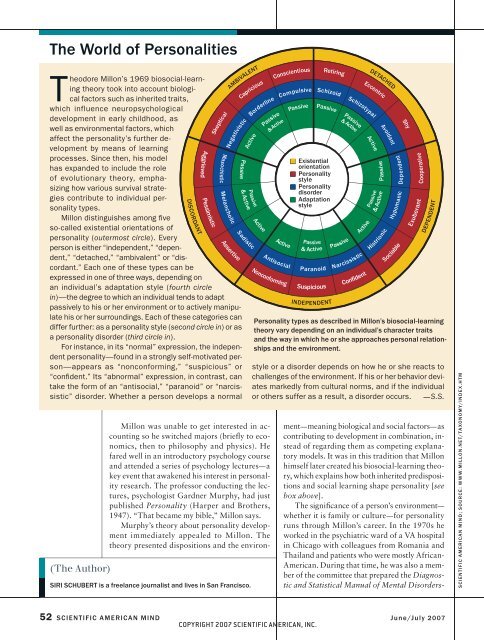Scientific American Mind-June/July 2007
Scientific American Mind-June/July 2007
Scientific American Mind-June/July 2007
You also want an ePaper? Increase the reach of your titles
YUMPU automatically turns print PDFs into web optimized ePapers that Google loves.
The World of Personalities<br />
Theodore Millon’s 1969 biosocial-learning<br />
theory took into account biological<br />
factors such as inherited traits,<br />
which influence neuropsychological<br />
development in early childhood, as<br />
well as environmental factors, which<br />
affect the personality’s further development<br />
by means of learning<br />
processes. Since then, his model<br />
has expanded to include the role<br />
of evolutionary theory, emphasizing<br />
how various survival strategies<br />
contribute to individual personality<br />
types.<br />
Millon distinguishes among fi ve<br />
so-called existential orientations of<br />
personality (outermost circle). Every<br />
person is either “independent,” “dependent,”<br />
“detached,” “ambivalent” or “discordant.”<br />
Each one of these types can be<br />
expressed in one of three ways, depending on<br />
an individual’s adaptation style (fourth circle<br />
in)—the degree to which an individual tends to adapt<br />
passively to his or her environment or to actively manipulate<br />
his or her surroundings. Each of these categories can<br />
differ further: as a personality style (second circle in) or as<br />
a personality disorder (third circle in).<br />
For instance, in its “normal” expression, the independent<br />
personality—found in a strongly self-motivated person—appears<br />
as “nonconforming,” “suspicious” or<br />
“confi dent.” Its “abnormal” expression, in contrast, can<br />
take the form of an “antisocial,” “paranoid” or “narcissistic”<br />
disorder. Whether a person develops a normal<br />
(The Author)<br />
DISCORDANT<br />
AMBIVALENT<br />
Millon was unable to get interested in accounting<br />
so he switched majors (briefl y to economics,<br />
then to philosophy and physics). He<br />
fared well in an introductory psychology course<br />
and attended a series of psychology lectures—a<br />
key event that awakened his interest in personality<br />
research. The professor conducting the lectures,<br />
psychologist Gardner Murphy, had just<br />
published Personality (Harper and Brothers,<br />
1947). “That became my bible,” Millon says.<br />
Murphy’s theory about personality development<br />
immediately appealed to Millon. The<br />
theory presented dispositions and the environ-<br />
SIRI SCHUBERT is a freelance journalist and lives in San Francisco.<br />
& Active & Active<br />
INDEPENDENT<br />
DETACHED<br />
Skeptical Capricious Conscientious Retiring Eccentric Shy<br />
Negativistic Borderline Compulsive Schizoid Schizotypal Avoidant<br />
Active Passive Passive Passive Passive Active<br />
Aggrieved Pessimistic Assertive Nonconforming Suspicious Confi dent Sociable Exuberan<br />
Masochistic Melancholic Sadistic Antisocial Paranoid Narcissistic Histrionic Hypoma<br />
Existential<br />
orientation<br />
Personality<br />
style<br />
Personality<br />
disorder<br />
Adaptation<br />
style<br />
Passive & Active Active Active & Active Passive Active & Active Passive<br />
Passive Passive Passive<br />
Personality types as described in Millon’s biosocial-learning<br />
theory vary depending on an individual’s character traits<br />
and the way in which he or she approaches personal relationships<br />
and the environment.<br />
style or a disorder depends on how he or she reacts to<br />
challenges of the environment. If his or her behavior deviates<br />
markedly from cultural norms, and if the individual<br />
or others suffer as a result, a disorder occurs. —S.S.<br />
ment—meaning biological and social factors—as<br />
contributing to development in combination, instead<br />
of regarding them as competing explanatory<br />
models. It was in this tradition that Millon<br />
himself later created his biosocial-learning theory,<br />
which explains how both inherited predispositions<br />
and social learning shape personality [see<br />
box above].<br />
The signifi cance of a person’s environment—<br />
whether it is family or culture—for personality<br />
runs through Millon’s career. In the 1970s he<br />
worked in the psychiatric ward of a VA hospital<br />
in Chicago with colleagues from Romania and<br />
Thailand and patients who were mostly African-<br />
<strong>American</strong>. During that time, he was also a member<br />
of the committee that prepared the Diagnostic<br />
and Statistical Manual of Mental Disorders-<br />
52 SCIENTIFIC AMERICAN MIND <strong>June</strong>/<strong>July</strong> <strong>2007</strong><br />
COPYRIGHT <strong>2007</strong> SCIENTIFIC AMERICAN, INC.<br />
nic Dep endent<br />
t Cooperative<br />
DEPENDENT<br />
SCIENTIFIC AMERICAN MIND; SOURCE: WWW.MILLON.NET/TAXONOMY/INDEX.HTM

















